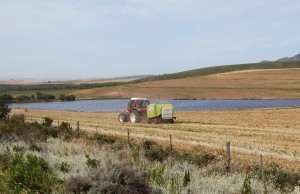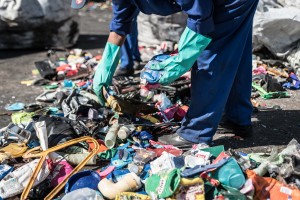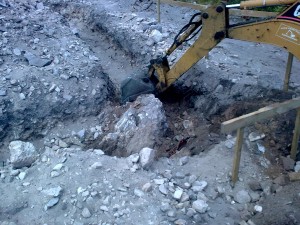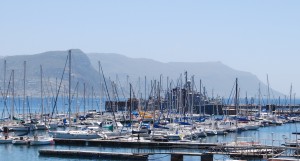CHAPTER < THREE - OUR FUTURE THROUGH A LOOKING GLASS CONTD...
From 1950 to 1990 the Western world was in the grip of a fever. It was a fever to grow, develop, advance, prosper and consume as never before. It was a period which has been called the Economic Era, and during this period of frenzied activity international trade increased by 12 times and global economic output quintupled.
 In 1990 two-and-a-half month’s global production equalled the production output of the entire year of 1950. In the decade from 1950 to 1960 water consumption increased threefold, and six times more oil was used than in previous decades. Between 1950 and 1984 world grain production increased more than two-and-a-half times, and between 1950 and 1989 world fish catches increased by more than three-and-a-half times. From 1950 world meat production increased five times. And in terms of global traffic, in the 1950s there were 50 million vehicles on the roads of the world with one car for every 46 people, but by the 1990s this gap had narrowed to one car for every 12 people, with over 400 million vehicles on the highways and byways of the planet.
In 1990 two-and-a-half month’s global production equalled the production output of the entire year of 1950. In the decade from 1950 to 1960 water consumption increased threefold, and six times more oil was used than in previous decades. Between 1950 and 1984 world grain production increased more than two-and-a-half times, and between 1950 and 1989 world fish catches increased by more than three-and-a-half times. From 1950 world meat production increased five times. And in terms of global traffic, in the 1950s there were 50 million vehicles on the roads of the world with one car for every 46 people, but by the 1990s this gap had narrowed to one car for every 12 people, with over 400 million vehicles on the highways and byways of the planet.
The Economic Era was a period when progress was defined by the production and consumption of a greater and more diverse range of goods than the world had ever seen before. Products like disposable nappies quickly became a labour-saving alternative to the old labour-intensive solution of washing and drying toweling nappies, and so indispensable was this invention to hard-pressed mothers that each year enough of them were used to stretch to the Moon and back seven times in a long, continuous line. In terms of resources this translated into one billion trees being cut down each year to provide the fluffy white liners that kept our babies dry.
Disposable, throwaway, time-reducing and labour-saving became powerful marketing bywords across a wide array of products. And a Western value system that was devoted to material acquisition rated these conveniences as having greater importance than the raw materials required to produce them. Deforestation, soil erosion and aquifer depletion had yet to become the global spectres they are now.
The Economic Era had ushered in an age of conspicuous consumption which had rapidly become a way of life in the developed world. It had also become a spiritual panacea and the means to personal fulfillment for millions of people in the Western world, and we entered into the spirit of excess with unthinking abandon. Planned obsolescence had arrived in a big, big way and it was a time of making more, buying more, using more and discarding more in an ever-widening circle.
Life for many of us became all about having: having the most fashionable labels and changing clothing, footwear and head wear the minute they were no longer in fashion. Having the right sporting or fitness gear. Having the most up-to-date computers and the sleekest cars. Having the highest state-of-the-art utilities and designer furniture in our homes. In short having anything and everything that our hearts desired and our money could buy. And in response to this forced consumption ethic we used more water, timber, energy, oil, metals, minerals and other non-renewable raw materials than had ever been used before in the same time span; all for a shopping list of throwaway items of questionable long-term value.
 What we couldn’t use or no longer wanted we dumped, until our garbage had choked the air, soil, rivers, lakes, ocean, cities and countryside everywhere. Nowhere on Earth was sacrosanct. On the highest peak of the planet, Mount Everest, known to the Tibetan people as “Chomolungma”, “Goddess Mother of the World”, and believed by them to be the closest place on Earth to heaven, the rubbish had piled up. Even in Antarctica, the icy, pristine snowfields had been befouled by human waste. And wherever men and women tramped the land or sailed the sea, garbage was sure to follow.
What we couldn’t use or no longer wanted we dumped, until our garbage had choked the air, soil, rivers, lakes, ocean, cities and countryside everywhere. Nowhere on Earth was sacrosanct. On the highest peak of the planet, Mount Everest, known to the Tibetan people as “Chomolungma”, “Goddess Mother of the World”, and believed by them to be the closest place on Earth to heaven, the rubbish had piled up. Even in Antarctica, the icy, pristine snowfields had been befouled by human waste. And wherever men and women tramped the land or sailed the sea, garbage was sure to follow.
Peace through Strength
But an over-zealous consumption ethic had not been the only culprit in the global garbage debacle. Also to blame was an over-heated nationalism in the West and East that had led to 40 years of cold war and weapons overkill. In a bid to deter attack, each side had thrown massive amounts of resources such as steel, aluminium, brass, bronze, copper, lead and other valuable raw materials into the making of combat aircraft, warships, submarines, battle tanks, shells and bullets; stockpiling them against the day when they might be needed in a deadly confrontation.
 When the tide of the cold war, with its prospect of thermonuclear annihilation, had turned, some of this arsenal was disposed of by dumping in the ocean. It was also buried on land, detonated or burnt in open-air pits – all crude, unimaginative disposal methods that discounted safety and environmental considerations. In the process this careless disposal of combat hardware poisoned the continents, sea and sky and the creatures that lived within these precious habitats.
When the tide of the cold war, with its prospect of thermonuclear annihilation, had turned, some of this arsenal was disposed of by dumping in the ocean. It was also buried on land, detonated or burnt in open-air pits – all crude, unimaginative disposal methods that discounted safety and environmental considerations. In the process this careless disposal of combat hardware poisoned the continents, sea and sky and the creatures that lived within these precious habitats.
During the forties, fifties and decades beyond, nuclear weapons, which were considered the ultimate deterrents, were extensively tested by military powers as yet not fully cognizant of the effects produced by fallout. Many nuclear devices were exploded around the world on land and under water. After a spate of such tests on the island of Enewetak, an atoll in the Pacific Ocean, thousands of tons of radioactive soil and debris scraped from testing sites were taken to a small deserted island called Runit Island. There, the hot soil and debris was entombed in a huge bomb crater covered over with a thick concrete dome.
Today this unsightly grey dome, which has the unlikely name of Cactus Crater, looks like the top of an alien spaceship landed on the island and sunken into the ground. It is artificial and out of place amidst the riotous green undergrowth of the island, and its smooth convex form, unnatural yet seemingly innocent, gives no hint of the malignant nature of the radioactive garbage that lies buried beneath it. Human intelligence had been able to conceive of the hydrogen bomb, but it was unable to find a way of disposing of its deadly by-products, except by the most primitive method of burying in virgin soil. Once again our intelligence had outstripped our foresight and it was the Earth that paid the price.
 Since World War Two, various governments around the world have amassed a collection of weapons of greater sophistication than has ever been produced before. This collective arsenal of conventional, chemical, biological and nuclear weaponry has the lethality to kill every living creature on the face of the planet. However, unless pockets of regional conflict and terrorist activity escalate into full-scale global warfare, which would obviously be a disastrous scenario, in terms of military progress, modern weapons today could end up as garbage tomorrow: garbage that could well choke us out of existence.
Since World War Two, various governments around the world have amassed a collection of weapons of greater sophistication than has ever been produced before. This collective arsenal of conventional, chemical, biological and nuclear weaponry has the lethality to kill every living creature on the face of the planet. However, unless pockets of regional conflict and terrorist activity escalate into full-scale global warfare, which would obviously be a disastrous scenario, in terms of military progress, modern weapons today could end up as garbage tomorrow: garbage that could well choke us out of existence.
There is a Swahili proverb that says: “Do not borrow off the earth, for the earth will require its own back with interest.” How long will it be before the interest due on the impact of human engineering on the Earth’s natural systems becomes due? Perhaps in many ways it already has…